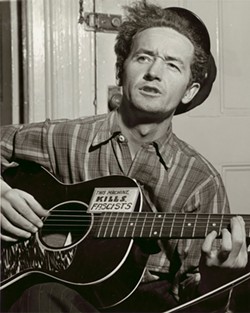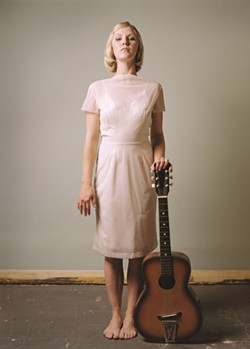Curator Leo Mazow is in his office talking about “Storied Strings,” his guitar exhibit coming to the Virginia Museum of Fine Arts, when the phone rings.
“Hi Lucy, can I call you back?” he says to the caller. It’s Lucy Kaplansky, noted folk-rock songstress, one of the participants in “Storied Strings”‘ studio music sessions. “She can’t wait to begin recording,” he says.
Studio music sessions… in a museum? “In the exhibit, there will be a recording studio where we’ve invited a number of national and regional musicians to explore the guitar,” he says.
The VMFA’s Louise B. and J. Harwood Cochrane Curator of American Art, Mazow has become known for thinking-outside-the-soundhole.
In 2019, he designed a working hotel room, in the style of painter Edward Hopper, for the exhibit, “Edward Hopper and the American Hotel.” He’s been working on “Storied Strings” for a good three years, and says he feels an obligation to go beyond the expected. “The Hopper project tells you a little bit about my own take on exhibitions. Like all the curators here, I really want to animate the space.”
The first exhibition to explore the guitar’s symbolism in American art from the early 19th century to the present day, “Storied Strings” is an eye-dazzling assemblage of more than 130 paintings, sculpture, works on paper, photographs, film clips (such as rare Carter Family footage featuring the influential Mother Maybelle Carter), along with more than 30 rare instruments.
Throughout the exhibit, the visitor will be treated to well known images — such as Al Aumuller’s 1943 portrait of Woody Guthrie playing a guitar bearing a sticker reading, “This machine kills fascists” — alongside historically-important but rarely seen works such as painter Thomas Hicks’ “The Musicale, Barber Shop” from 1855, the earliest known depiction of an integrated musical group in American art. While there are featured icons — Bruce Springsteen, Josh White, Prince — there are just as many ordinary folks holding, hugging, strumming and picking their axes.
There are also side lectures and events planned during the exhibit’s run, on subjects ranging from guitar making to the music of Elizabeth Catlett, and the museum has partnered with Starr Hill Brewery to make a limited edition “Storied Strings” lager — because guitars and beer just seem to go together.
And then there’s the recording studio. Situated in the middle of the show, a glass-fronted space — built by local In Your Ear studios — will be used to record accomplished guitarists at various times during exhibit hours. Lucy Kaplansky will join the likes of popular blues rocker Tommy Emmanuel, Wilco’s Nels Cline, Charlottesville bluesman Corey Harris, and, from Richmond, The Jayhawks’ Stephen McCarthy with ace picker Charles Arthur. The individual sessions by these players and others during the exhibit’s run won’t be announced in advance, Mazow informs. “They’ll just happen at random. For visitors, it will be the luck of the draw.” The recordings will be posted on the museum’s website and YouTube channel.
In essence, these musicians will be a living part of the art on display.
“Each of them will play a few songs and speak with us about what the guitar means to them and how it works as an expressive tool in their music,” says the curator, himself a semi-gigging fretsman. “What does it mean for the guitar to tell stories?”
Leo Mazow sat down with Style Weekly to talk about the ambitious “Storied Strings” and about how the guitar — in all its shapes and uses — has become such a potent symbol in both American life, and art.
Style Weekly: What’s so important about the guitar?
Leo Mazow: As a colleague says, it’s the storyteller’s companion. But that’s just in terms of music. There’s never been an exhibition, that I’m aware of, that surveys the guitar in American art, and it’s important to study it because the guitar figures so prominently in the stories we tell ourselves about ourselves.
Sometimes the stories are quite direct, like the pictures we will show of Leadbelly or a person in a work camp during the Depression. In other ways, the guitar is more of a motif, a formal problem that an artist sets out to depict. The exhibition, looking at both of these types, is divided into ten categories, one of which features European prototypes for the guitar, instruments like the cittern appear in a few paintings, and the mandolin.
People love to pose with the guitar, and as your exhibit shows, visual artists love using them as a prop.
We have one section, “Guitar Welding Women,” that shows women using the guitar as an emblem of accomplishment or achievement. This goes into the present day in which a handful of [female] artists in the 20th and 21st century have used the guitar as a check on the male heroics of, for example, rock music. Much earlier, in the early 20th century, there were a number of pictures of women using the guitar to establish a sense of gravitas, and a sense of their own status as somebody who works with their head and their hands.
How about the guitar as a symbol of status?
There’s a section called Cold Hard Cash that looks at that very aspect. There will be a guitar in that part that is truly meant to be seen, with all of the carving and the mother of pearl inlay, more than it is to be played. To this day, not unlike cars, a nice guitar can say something nice or privileged about oneself.
At the same time, as you show, it has also helped those who aren’t so privileged.
Yes. For instance, the guitar features quite predominantly in Black art and culture. We show how, by the late 19th century, the guitar had replaced the banjo in popularity, because the banjo gave a racially vexed charge. The guitar became one of the prime instruments in navigating the territory of the blues. And it was a novel notion – the whole idea of using a musical form to express for expression’s sake, to say things that would otherwise not be heard, not taken seriously, in another medium.
Does the exhibit explore the guitar’s use as a phallic symbol?
That’s more of a pop culture phenomenon. We do have a couple of album covers that speak to that. What we find a lot more is the guitar as an extension of the individual playing it. This can be simply by the subject hugging or embracing the guitar, or holding it in a way a parent might hold a child. We have on display excerpts from a diary from the 19th century in which an individual related to the guitar like a friend – like the psychological extension of herself.
You’ve said you learned a great deal putting this together.
This has been quite the journey for me. I’m a good guitar player. And I’ve written about the meaning of music in art, and sound in art, but I didn’t know a lot about the guitar as a busking device, say, or as a moneymaking tool for blind people, or what makes a guitar a Spanish guitar.
You are calling the live-in-studio performances the Richmond Sessions, a nod to the Bristol Sessions.
Everyone uses the word sessions because it evokes Bristol. For instance, In Your Ear has their awesome Shockoe Sessions. The Victor Talking Machine Company sort of invented country music with the Bristol Sessions, and the themes in those songs ranged from courtship and Christianity and trains and transportation to mortality.
It’s my hope that, as with those 1927 recordings, these Richmond Sessions will enlist the guitar in a thoughtful sort-of exploration of personal relationships, national identity, popular religion, a sense of place, gender and sexuality. I may not say ‘hey, let me talk to you about my love/hate affair with the United States,’ or tell you about my shifting sexuality but I can play a song about it and I’m comfortable talking to you about it in the space of the guitar.
”Storied Strings: The Guitar in American Art” runs at the Virginia Museum of Fine Arts from Oct. 8 through March 19, 2023. For more information on the exhibit and accompanying lectures and side events, go to https://vmfa.museum
Guitarists participating in the “Richmond Sessions,” held at unspecified times during the exhibit’s run, will include Yasmin Williams, Corey Harris. Nels Cline, Tommy Emmanuel, Stephen McCarthy and Charles Arthur, Lucy Kaplansky, Joel Harrison and Anthony Perog and Seamus McDaniel. To follow the sessions as they progress, go to youtube.com/virginiamuseum























Discussion about this post